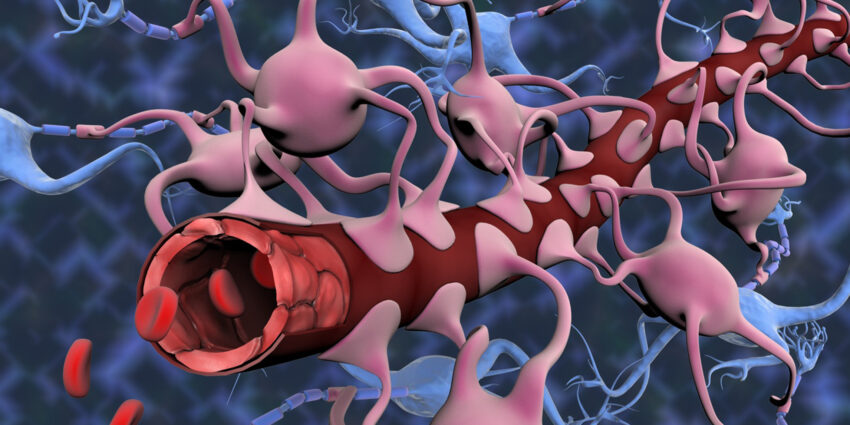Introduction
The Blood Brain Barrier (BBB) is a highly selective semipermeable membrane barrier that separates the circulating blood from the brain extracellular fluid in the central nervous system (CNS). Strictly speaking, the blood–brain barrier is present at the capillary endothelial level in the brain and restricts the passage of substances from the blood to the extracellular fluid of the CNS. The BBB protects the brain from harmful substances circulating in the blood while providing nutrients and oxygen.
Anatomy and Physiology of the Blood Brain Barrier
The BBB is formed by brain capillary endothelial cells linked together by tight junctions. These tight junctions reduce the permeability of the capillaries and prevent solutes in the blood from freely entering the brain. Surrounding these endothelial cells are pericytes, which are contractile cells that participate in the regulation of blood flow and angiogenesis. Microglia and astrocyte end-feet processes highly ensheath the abluminal aspect of the capillary endothelial cells. Both pericytes and astrocytes are therefore involved in maintaining BBB integrity.
There are several characteristics of brain capillaries that differentiate them from peripheral capillaries and contribute to the selective permeability of the BBB. Brain capillaries have tight junction complexes connecting adjacent endothelial cells, preventing paracellular diffusion of solutes through intercellular clefts. They also have fewer fenestrations, caveolae, and transport vesicles compared to peripheral capillaries. Furthermore, brain capillary endothelial cells have higher mitochondrial content and lower Pinocytic vesicle activity than in endothelial cells outside the CNS.
Transport Mechanisms Across the Blood Brain Barrier
Substances can cross the BBB via three main mechanisms – transcellular transport, paracellular transport and transcytosis. Transcellular transport is the transport of specific substances across the endothelial cell membrane via carrier-mediated facilitated transport or active transport. Examples include glucose and amino acid transporters. Paracellular transport occurs through tight junctions between endothelial cells and is highly selective. Transcytosis is the transport of macromolecules through endothelial cells via receptor-mediated endocytosis and exocytosis.
Role of the Blood Brain Barrier
The BBB plays a crucial protective role by preventing the entry of various drugs, toxins and plasma proteins from entering the brain. It allows selective passage of essential nutrients like glucose and amino acids needed by the brain. This maintains a stable neurological microenvironment necessary for normal brain function. The BBB is also selectively permeable to gases like oxygen and carbon dioxide, regulating neuronal activity levels.
Breakdown of the Blood Brain Barrier
The BBB can breakdown or become more permeable in various disease states and conditions. Stroke, brain tumours, trauma, neuroinflammatory diseases like multiple sclerosis, infections and metabolic disorders can disrupt tight junction integrity and increase BBB permeability. Certain diseases may also alter transport mechanisms across the barrier. Abnormal BBB permeability has been implicated in neurological disorders, making targeted drug delivery to the CNS difficult. Researchers are pursuing ways to transiently open the BBB in a safe and targeted manner to allow drug entry for treating brain diseases.
Global Significance and Future Implications
The blood–brain barrier regulates what enters the brain and is crucial for brain homeostasis. With increasing global prevalence of neurodegenerative diseases, neurological disorders, brain tumours and infections affecting the CNS, understanding BBB physiology and pathology is paramount. Elucidating its complex transport mechanisms and identifying factors regulating permeability are active areas of research worldwide. Numerous global collaborations aim to develop novel strategies for targeted drug delivery across the BBB, advance neuroimaging techniques to detect BBB breakdown non-invasively and discover new therapeutic targets modulating its function in diseases. The blood–brain barrier holds tremendous potential for impacting brain health globally by enabling treatment of previously untreatable neurological conditions.
Conclusion
In summary, the blood–brain barrier is a highly specialized interface that protects the brain while regulating molecular exchange. It plays a key role in normal brain physiology and neurologic function. Dysfunction or disruption of the BBB has pathogenic consequences and contributes to the progression of various brain disorders. Further insights into blood–brain barrier structure, transport, regulation and pathology have immense global significance for the development of improved diagnostics and new therapeutic strategies targeting the brain. Understanding this biological interface has far-reaching implications for advancing neurological healthcare worldwide.
*Note:
1. Source: Coherent Market Insights, Public sources, Desk research
2. We have leveraged AI tools to mine information and compile it

